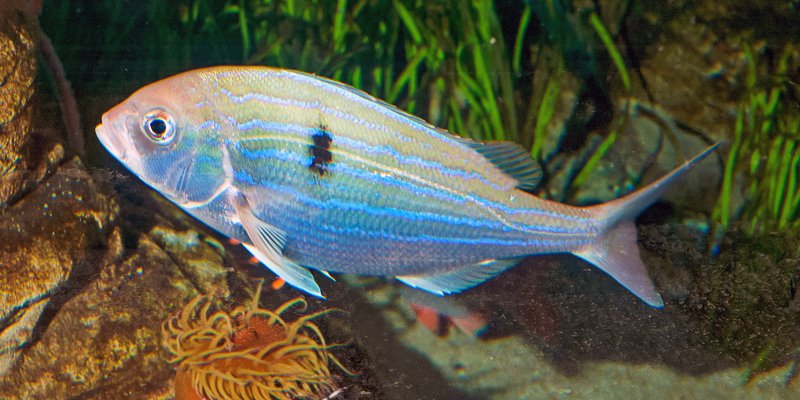Fisheries Management Gives Hope for Seventy-four Seabream Recovery
Blueprint
ASSESS
In 1910, a handful of hand-line fishing boats operating out of Durban Harbour, South Africa, were catching over 1,000 tonnes of Seventy-four Seabream per year, according to the harbour master’s records. By the 1950s, catches had halved, despite increasing fishing effort. By the late 1980s, commercial fishers caught less than 10 tonnes of this popular seafood species per year. Commercial hook-and-line fishing boats in the province of KwaZulu-Natal is a multi-species fishery with the Seventy-four Seabream being among the many species caught. While in the 1980s this fishery supported the livelihoods of about 100 boats, the present fishery comprises just over 40 licenced boats with an average of six crew per boat.
In the early 1960s, scientists at the South African Association for Marine Biological Research (SAAMBR) Oceanographic Research Institute in Durban, began investigating the biology of the Seventy-four Seabream population. It was noted that their historic distributional range along the southeastern coast had contracted in size considerably. Retrospective analysis of historical catch data in the mid-1990s, revealed that the population had indeed collapsed in 1960 and by the mid-1990s its numbers were estimated to be down to less than 5% of its pristine (before fishing) level.
PLAN
In the mid-1980s, the first fishing regulations were created to protect the Seventy-four Seabream. These included a minimum size limit, daily catch limit per person, and a closed season during spawning; however, these regulations were too little and too late. Analysis of data post-regulation revealed that catches were still declining. Therefore, in 1998, after extensive negotiations between the responsible government department and local fishermen, a moratorium was placed on all Seventy-four Seabream captures in South Africa. The goal of this policy was to aid recovery of the species, over a 10-year period. Fishermen were swayed to accept the moratorium as they realised a failure to act could drive this species to extinction.
In 2007, a population reassessment revealed that the species showed some signs of recovery in juvenile abundance. However, it was determined recovery of adult fish was not substantial enough to allow the fishery to be reopened and the catch moratorium was set to continue for at least another five years. Data from these population assessments and catch history were used to create the first IUCN Red List of Threatened Species assessment. The species was evaluated as Critically Endangered using Criteria A, which highlights the historic and ongoing population decline.
ACT
In addition to traditional fisheries management, a number of large no-take marine protected areas (MPAs) have been established along the South African coast. One of the most recent MPAs extends out to a 1,000 metre depth and is designed to play a role in protecting adult fish. The Dwesa-Cwebe, Amathole, and Bird Island MPAs currently play an important role in providing protection for juvenile Seventy-four Seabream and other offshore reef fish that are resident. The Aliwal Shoal MPA was recently extended to include some of the historical deep reef spawning grounds that are particularly important during spring (August to October) where Seventy-four Seabream aggregated in large numbers on the Illovo Banks.
Today, after 23 years, the moratorium has remained in place but a full population assessment is planned for the near future. Monitoring this species traditionally included fishery-dependent data, so the fishing moratorium has meant that researchers have had to adjust their methods to assess the species’ status. Regulations are enforced by government officials but limited poaching still exists, driven by black market demand and is likely hampering recovery. Long-lived, late maturing species such as the Seventy-four Seabream are generally more susceptible to overexploitation, even at low levels of fishing.
Results
Anecdotal reports by ski-boat fishermen (smaller boats launched from shore), especially along the Eastern Cape coast of South Africa, suggest that the number of Seventy-four Seabream has increased significantly. These reports state that the recovery of the species has been so significant that there are now areas where it is the dominant reef fish species incidentally caught. Observations using Baited Remote Underwater Video cameras have also shown high numbers of Seventy-four Seabream in these areas.
However, the large spawning aggregations of Seventy-four Seabream that used to occur on the KwaZulu-Natal south coast during spring have not yet reappeared. The recent expansion of the protected area that includes the Illovo Banks is expected to help encourage recovery of reproductive adults.
Together with the moratorium, these recovery efforts suggest that restoration of the Seventy-four Seabream population is feasible, but it will require a longer duration and continued enforcement of the regulations. In time, with careful future management of the species, it may be possible to reopen the fishery to a low level with strictly controlled fishing practices.
Visual & Audio References
©Judy Mann
Collaborations
Major
Partners
South African Association for Marine Biological Research (SAAMBR) Oceanographic Research Institute
Fisheries Branch of the South African Department of Forestry, Fisheries and the Environment
South African Marine Linefish Management Association
Additional
Contributors
Natal Parks Board - now Ezemvelo KZN Wildlife
South African Institute for Aquatic Biodiversity
Donors
South African Association for Marine Biological Research, Department of Forestry, Fisheries and the Environment
Content Updated as of 3/21/2022








